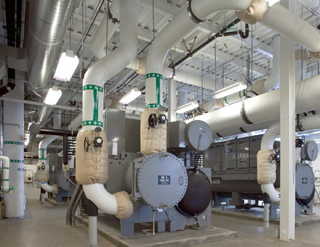
Wood Harbinger
Specialty: Mechanical, electrical and industrial systems engineering
Management: Bob Axley, Phil DeBels, Bruce Alward, Bill States, Tom Leonidas Jr.
Founded: 1967
Headquarters: Bellevue
2010 revenues: $16 million
Projected 2011 revenues: Close to $17 million
Employees: 95
Current projects: Highway 520 bridge replacement; new naval pier at Bangor; University of Oregon infrastructure work; ongoing Boeing projects

Photo courtesy of Wood Harbinger Wood Harbinger worked on the design of the University of Oregon’s rebuilt chilled water plant. |
Wood Harbinger is proof that a diverse practice can help shield an engineering company from the vagaries of the economy.
The company’s clients range from Boeing and the military to educational and health-care facilities, and its revenues have increased. “The key to our success has been that range and variety of work,” said Bob Axley, president and CEO of the employee-owned company.
The workload over the last two-and-a-half years has “pretty much surprised us,” said Axley. He anticipates the amount of work will stay “pretty level” in 2012, and does not plan to significantly change the size of the staff, though the company could add two or three engineers.
Helping Boeing
Among the various sectors Wood Harbinger serves, the military, Boeing, health-care and infrastructure have been the most active.
Wood Harbinger helped Boeing redesign its assembly process for the 787. That led to a redesign of the company’s 747 and 767 assembly lines. Wood Harbinger helped with utility and infrastructure design.
At the Bangor naval base, Wood Harbinger is involved in the design of the $715 million wharf that will be used to load and unload ballistic missiles from Trident submarines. The company is engineering mechanical and electrical systems.
Health-care spending dwindled during the recession, but is coming back. Congressional reform of the health-care system is changing the way hospitals operate. This, along with advances in technology, have led to more work for Wood Harbinger.
Axley says the company is excited to be starting on the electrical and mechanical engineering of the new Highway 520 bridge, which he called a sophisticated project.
Wood Harbinger is working with the University of Oregon, which is rebuilding its steam, chilled water and emergency power plants. The company is starting to work with the university on a cogeneration facility that will have a gas turbine.
Fee pressure
Industry-wide, Axley says engineers are being asked to negotiate more reasonable fees. “Everybody is strapped for money,” he said. “There has been a lot of pressure to keep costs down. We are having to sharpen our pencil.”
He’s also seeing increasing use of the integrated design process. While the design-build method has been around for years, “it’s poking up more in different areas.”
One key personnel change for the company was the January retirement of vice president Jim Jenkins, a member of the management team. Wood Harbinger hired Tom Leonidas Jr. as executive vice president, in part, to help with the transition. Leonidas is an electrical engineer who works on health-care, commercial, higher-education and municipal facilities.